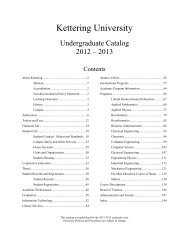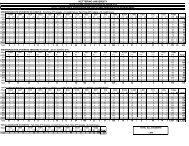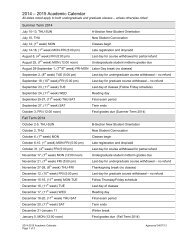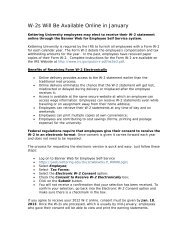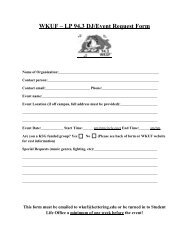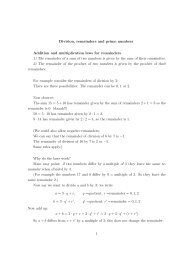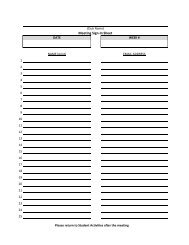1 CLASS LECTURE NOTES - What is Applied Statistics ...
1 CLASS LECTURE NOTES - What is Applied Statistics ...
1 CLASS LECTURE NOTES - What is Applied Statistics ...
You also want an ePaper? Increase the reach of your titles
YUMPU automatically turns print PDFs into web optimized ePapers that Google loves.
- Raw data: not compiled in any way.<br />
- Grouped data: classified into several groups or classes according to some criteria.<br />
15<br />
UNI- AND MULTI-VARIATE DATA<br />
If the study involved <strong>is</strong> only on one variable, such as the MPG of a new model car as a function of<br />
the size of the car then we are dealing with univariate data. However, if the study deals with more<br />
than one variable at a time, then we are dealing with multivariate data. For example, if we are<br />
interested in the study of MPG as a function of the engine size, HP, passenger capacity, fuel capacity,<br />
etc, then the study deals with multivariate data.<br />
MULTIVARIATE ANALYSIS<br />
Multivariate analys<strong>is</strong> deals with study involving simultaneous measurements on many variables.<br />
Multivariate stat<strong>is</strong>tical techniques differ from univariate in the sense that the attention <strong>is</strong> drawn away<br />
from the analys<strong>is</strong> of mean and variance of a single variable. Instead, the attention <strong>is</strong> focused on:<br />
(i) Data reduction;<br />
(ii) Sorting and grouping;<br />
(iii) Study of dependence among variables.<br />
There are several multivariate techniques available for investigating the above three areas. These<br />
include: (a) multiple regression; (b) d<strong>is</strong>criminant analys<strong>is</strong>; (c) multivariate ANOVA; (d) correlation<br />
analys<strong>is</strong>; (e) logit analys<strong>is</strong>; (e) principal component analys<strong>is</strong>; (f) factor analys<strong>is</strong>; (g) cluster analys<strong>is</strong>;<br />
(h) metric multidimensional scaling.<br />
In th<strong>is</strong> course, we will concentrate only on the principal component analys<strong>is</strong>. First, you need to review<br />
your matrix algebra, specifically the concepts of linear combination, eigenvalues, eigenvectors, and<br />
positive definite matrices.<br />
PRINCIPAL COMPONENT ANALYSIS<br />
The main idea of principal component analys<strong>is</strong> deals with explaining the variance-covariance<br />
structure of the variables under study through a small number of linear combinations of the original<br />
variables. These linear combinations are constructed in such a way that much of the total variation<br />
in the original variables <strong>is</strong> explained by these few linear combination ones. Thus, we are concerned<br />
with data reduction (in the form of identifying a small number of linear combinations of the original<br />
variables) and interpretation. It should be noted that principal components serve as intermediate steps<br />
in multiple regression (to be seen later), factor analys<strong>is</strong> and cluster analys<strong>is</strong>.



